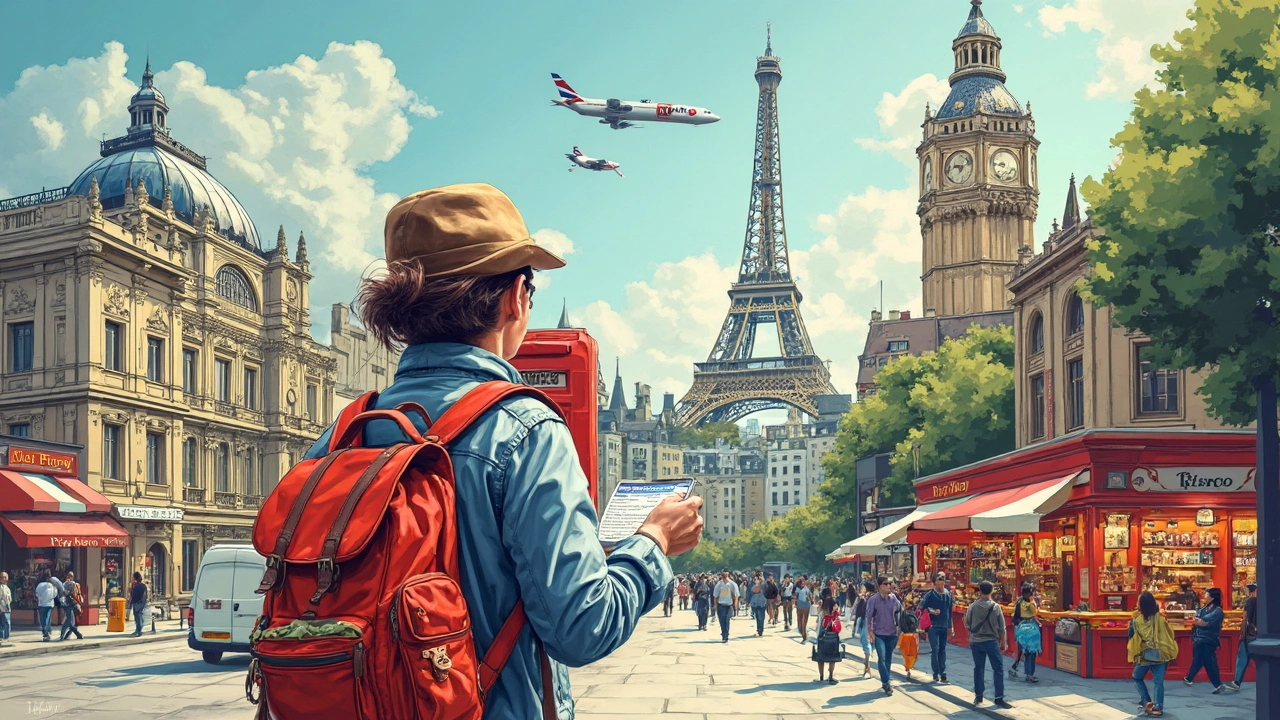If you’ve been eyeing flight deals and weighing up your annual leave, three nights for a city break probably sounds tempting. But can you really get under the skin of a city in just 72 hours? The short answer: Yes, if you play it smart. More days are always nice, sure, but most folks underestimate how much you can do with a little focus and a pinch of planning.
The trick is to build your trip around priorities. Don’t try to cram a city’s every secret into three days—it’s just not going to happen, and you’ll end up tired and annoyed. Instead, pick two or three must-see sights, a couple of local spots for food, and block out a bit of downtime to wander. That way, you get the highlights and a taste of local life without stress-overload.
- The Three-Night Formula: How Much Can You Actually See?
- Tips to Maximize Your Time
- Common Pitfalls—and How to Avoid Them
- Choosing the Right City for a Short Break
- When Less Is More: The Beauty of Quick Trips
The Three-Night Formula: How Much Can You Actually See?
So what can you really pack into a city break with just three nights? Here’s the deal: a lot comes down to picking a city that matches your vibe and energy level. Most travelers report feeling way more refreshed after a focused three-night trip than a random stretched-out holiday. In fact, a 2023 survey by European Travel Commission found that 62% of young adults said three nights felt like the sweet spot—not too rushed, but enough to check off their must-dos.
The key is realizing you’ll have about two and a half actual days, once you factor in arrival and departure times. That leaves you right in the Goldilocks zone—not too short, not too long. You get a taste of the place, with time for its biggest attractions, some hidden gems, and a few relaxed moments along the way.
| Number of Nights | Average Number of Top Sights Visited | Recommended Cities |
|---|---|---|
| 2 Nights | 3 | Bruges, Salzburg |
| 3 Nights | 5-6 | Lisbon, Prague, Barcelona |
| 4 Nights | 7-8 | Rome, Paris, London |
With a city break of three nights, people usually cover five or six major sights—think walking tours, a museum, a neighborhood exploration, and a food spot or two. Not sure how realistic that sounds? In Barcelona, for example, you could easily squeeze in the Sagrada Família, stroll down Las Ramblas, hop between tapas bars, check out the beach, and catch a Gaudí house in three days without running yourself ragged.
The secret sauce to making the most of it: focus your days by geography. Group attractions by neighborhoods each day so you’re not zigzagging all over town. And don’t forget travel time—big cities with spread-out sights (like London) need more planning. Small or compact cities are a breeze with three nights, while huge metropolises might leave you craving more but still let you hit the highlights.
Tips to Maximize Your Time
Three nights fly by, so you’ve got to be smart about how you spend each hour. There’s no shame in planning ahead—it actually gives you far more freedom to enjoy the moment once you’re there. Booking tickets for popular attractions in advance isn’t just a time-saver; in places like Barcelona’s Sagrada Familia or Amsterdam’s Anne Frank House, it’s the only way you’ll get in without a long wait (or missing out altogether).
Map out each day loosely. Group places by neighborhood to save time trekking back and forth. Big cities like Paris or Rome are notorious for having their hot spots scattered all over, so check a map before you build your schedule. Most sightseeing time is lost not at sights themselves, but getting from A to B.
- Pick a centrally located hotel or apartment, even if it costs a bit more—you’ll gain actual free time, not just sleep.
- Skip luggage drop-offs and airport headaches by packing light and sticking with carry-on bags. Less waiting, less baggage claim drama.
- Look for hop-on, hop-off bus tickets or day transit passes—they can save you cash and let you cover more ground fast.
- Avoid wasting ages flipping through restaurant reviews. Screenshot three local food spots beforehand, and just walk there when you’re hungry.
- Don’t overschedule—leave some wiggle room. Some of the best memories come from spontaneous detours.
Here’s a quick reality check on how much time you’ll likely spend in a typical city break day, based on common activities:
| Activity | Average Time Spent (hours) |
|---|---|
| Sightseeing | 4–6 |
| Eating/Drinks | 2–3 |
| Getting Around | 1–2 |
| Rest/Downtime | 2 |
Pro Tip: Set up your phone on offline Google Maps before you go. Save key places to your favorites. That’s one less thing to stress about when you’re lost or trying to find lunch with 5% battery left.

Common Pitfalls—and How to Avoid Them
Three-night city breaks always look great on paper, but mistakes can eat up your time and leave you feeling like you hardly saw anything. One classic trap: over-packing your schedule. People often try to fit too much in and end up spending more time in transit than actually enjoying the place.
- Research before you go: Know opening hours, days when museums or landmarks usually close (it’s always Mondays or Tuesdays, right?). Big cities like Paris or Barcelona have major museums that shut on those days, and you don’t want to show up to locked doors.
- Watch out for travel times between sights. Google Maps is your friend here, but also check for real-time local transit strikes—Paris, London, and Rome all have their share.
- If you want to eat at a famous spot, book ahead. Some places are booked out weeks in advance, especially in foodie cities like Rome, Tokyo, or Barcelona.
- Trying to see too many neighborhoods can be a time thief. Stick to a couple of areas each day so you’re not spending your whole trip on public transport.
- Jet lag can wreck your first day if you’ve crossed more than one or two time zones. If your flight lands early and your hotel room isn’t ready, stash your bags somewhere safe and go grab a coffee to reset.
Missing out because you bought tickets too late or showed up when something’s closed really stings on a short trip. About 35% of travelers on city breaks report disappointment due to poor planning, according to a survey by Hostelworld in 2023. Most didn’t realize their top sight needed advance booking or had limited entry slots.
| Pitfall | How To Dodge It |
|---|---|
| Packing too much into each day | Pick must-do's, add free time for wandering |
| Not checking opening days/hours | Google every spot before your trip |
| Ignoring local events or strikes | Check city news and transport updates |
| No reservations for eating out | Book top restaurants weeks early |
| Geographically scattered planning | Group sights by area, focus your days |
Simple fixes—book things early, know what’s open, and plan smart routes—can save you hours and loads of frustration during your city break. And remember, not every single museum or monument needs to be on your list. Sometimes grabbing a pastry on a hidden side street is just as memorable as ticking off the big stuff.
Choosing the Right City for a Short Break
Not every city fits neatly into a three-night window. The best city break spots make it easy to get around, pack a punch with attractions close together, and offer some good food within walking distance. Think about this: you don’t want to spend half your break sitting in traffic or feeling lost on complicated transit lines, right?
Europe nails the city break game, mostly because places like Amsterdam, Prague, and Lisbon have compact centers. You’ll find tons of sights in easy reach. For example, Amsterdam’s Museum Quarter, canal walks, and street markets can all be covered by foot or a short tram ride. The city is about the size of Austin, Texas, but with a ton more culture packed in per square mile.
Now, here are a few things to keep in mind when picking your city:
- Go for a city with a well-connected airport. London, Paris, Barcelona, and Berlin handle millions of short-trip travelers each year, thanks to loads of direct flights and low-cost carriers.
- Check the size. A huge city like Istanbul or Los Angeles is amazing, but three days barely scratches the surface. Cities like Vienna, Budapest, or Florence are far more doable.
- Transport is key. Cities with tourist-friendly metro systems (like Madrid or Munich) save loads of time getting from A to B, while cities loaded with hilly streets (like Lisbon) can slow you down if you’re not prepared.
- Look up opening days. Some cities basically shut down big attractions on Mondays or Tuesdays. Better to find out now than when you’re standing outside a closed museum on your only free morning.
To help you out, here’s how some top cities stack up for the perfect three-night break:
| City | Airport Transfer (Minutes to Center) | Main Sights Distance (Walking) | Public Transit Pass (Per Day) |
|---|---|---|---|
| Amsterdam | 20 | Most within 30 minutes | €9.00 |
| Prague | 30 | Most within 40 minutes | €5.00 |
| Florence | 25 | All walkable | N/A (Barely needed) |
| Barcelona | 35 | Central sites under 30 minutes | €8.15 |
The bottom line? Prioritize places you can reach fast, explore easily, and experience intensely—without racking up wasted hours. Stick to cities that don’t take a week just to get your bearings, and you’ll actually remember the trip for more than its airport lounge.

When Less Is More: The Beauty of Quick Trips
Here’s the thing people rarely admit—short getaways often beat those marathon vacations. When you’ve got just a few days, you spend your energy wisely. You don’t waste time on “maybe someday” plans or get sidetracked by every random attraction. You focus in on what matters most and, honestly, that can be a relief.
There’s research to back this up. A 2022 travel study by Expedia found that short trips (three to four nights) left 76% of travelers feeling more recharged than longer breaks, which tend to get bogged down with over-scheduling and travel fatigue. Turns out, when you know your time is short, you shed the guilt of missing out and actually enjoy the moment more.
Quick trips mean less packing, less expense, and way less planning stress. If something doesn’t go as planned, you don’t feel like you wasted an entire week. And if you truly love a place, it gives you a reason to come back. Here’s why these short breaks shine:
- City break trips are manageable. You don’t need weeks off work, and last-minute deals can totally work in your favor.
- Choosing just a handful of sights avoids burnout. You remember more because you’re not running around non-stop.
- You travel lighter—carry-on bags only, no fuss with big suitcases or lost luggage drama.
- Short visits usually mean less money spent on accommodation and food, leaving more in your budget for cool experiences (think local tours or street food tastings).
If you’re wondering how much you can see or do, check out some quick stats:
| Trip Length | Avg. Attractions Visited | Reported Enjoyment (1-10) |
|---|---|---|
| 3 nights | 5-7 | 8.2 |
| 7 nights | 8-12 | 7.9 |
Sometimes, less really is more. You get the highlights, minimize hassle, and keep that travel buzz alive through the whole trip. It’s the best way to squeeze adventure into a tight schedule and still come home with stories worth sharing.
